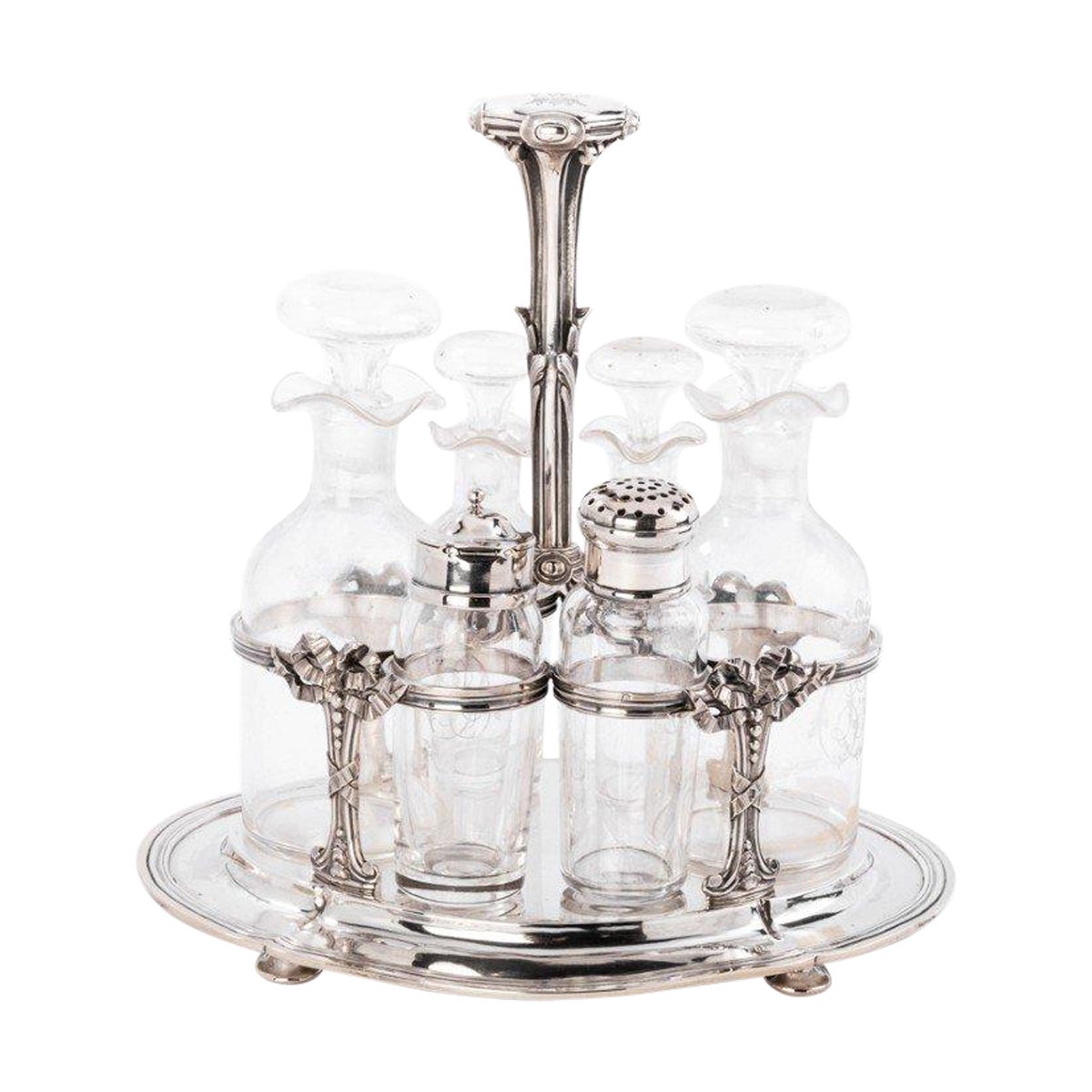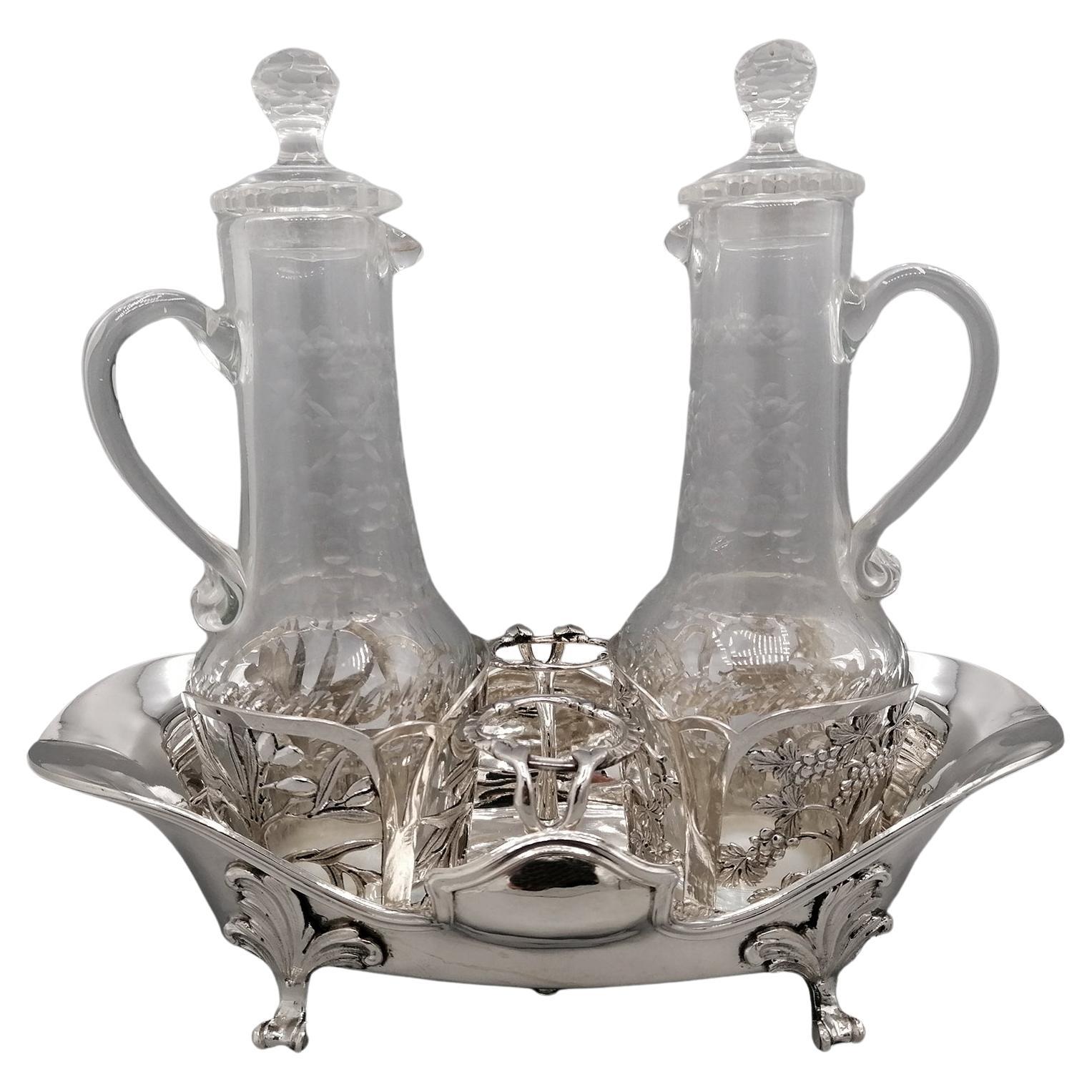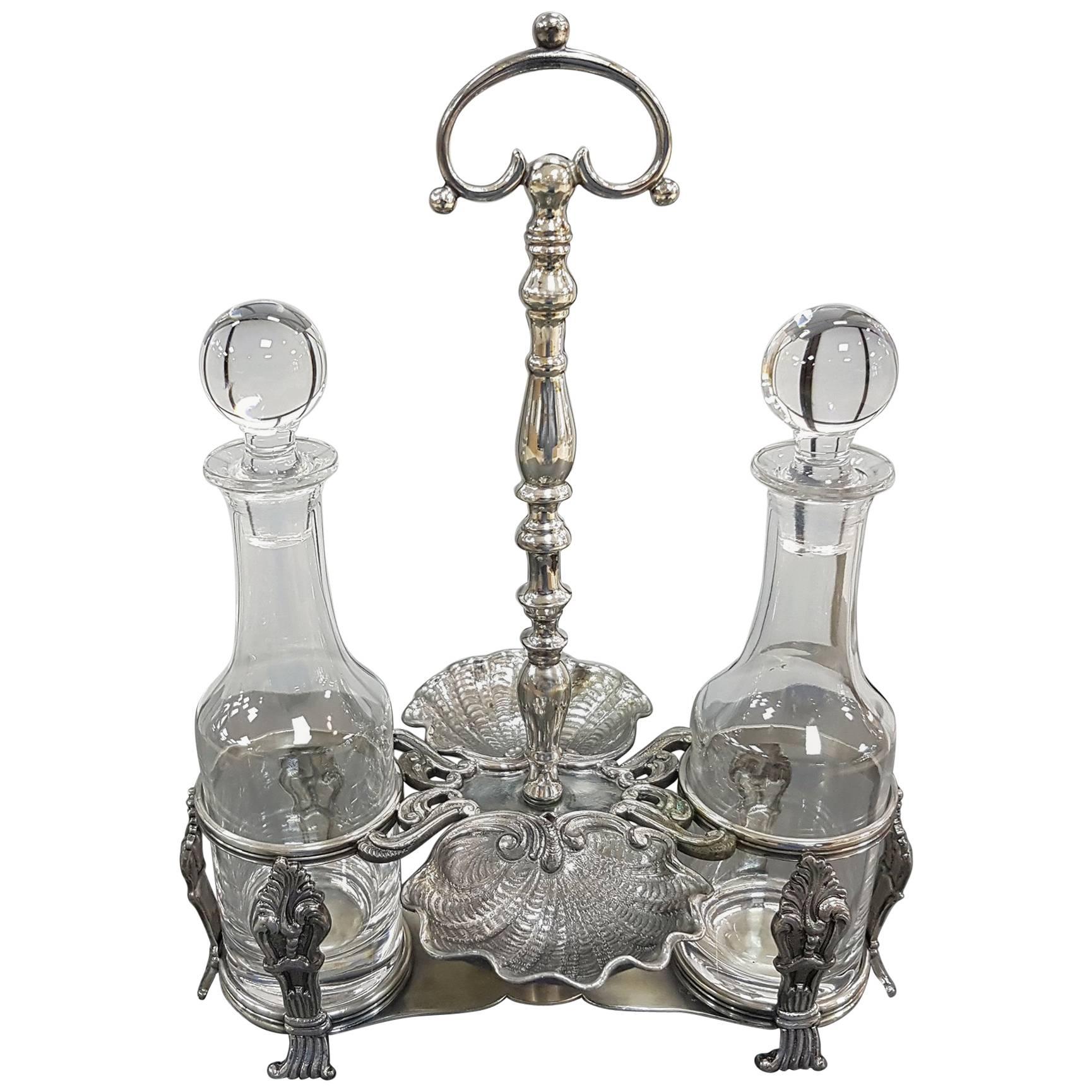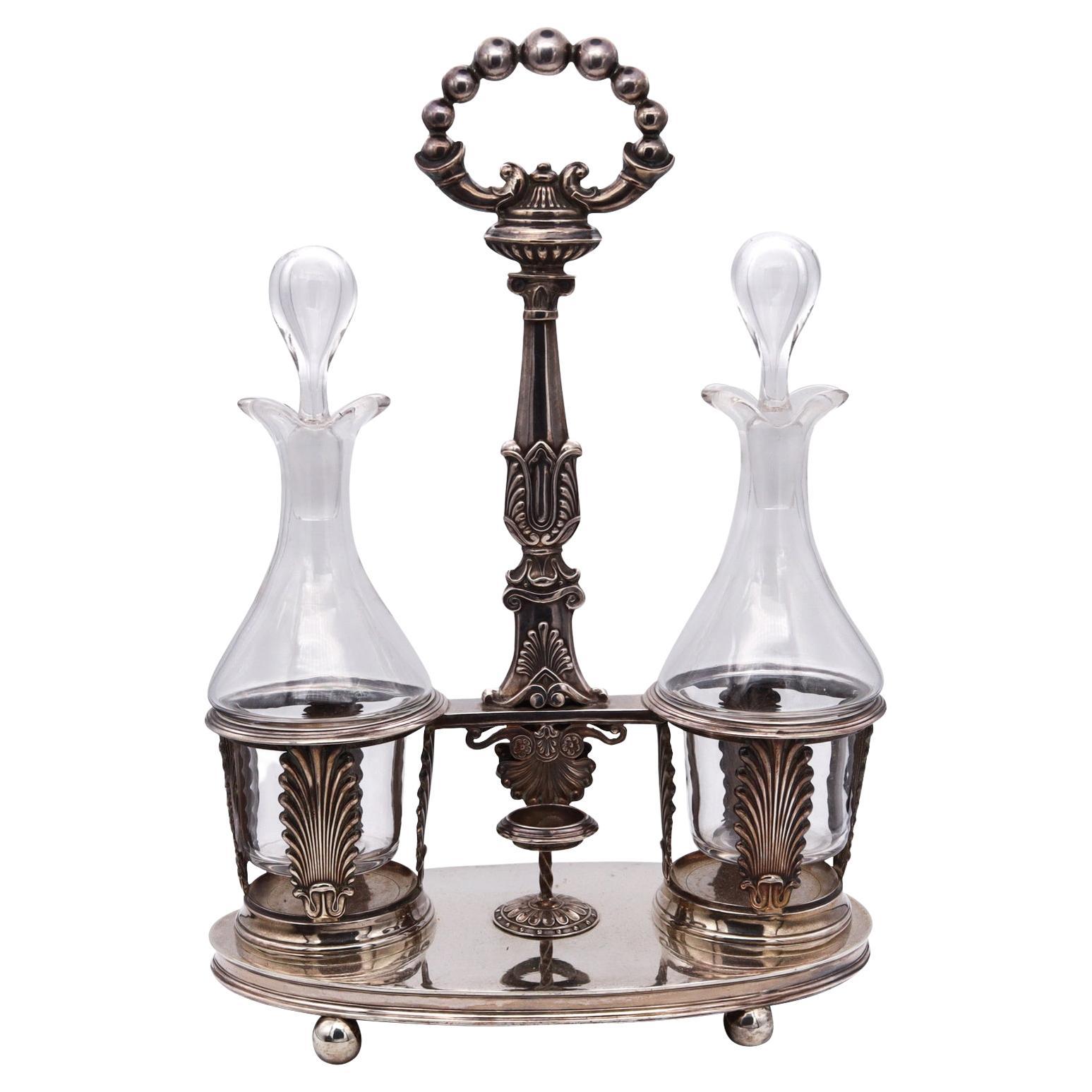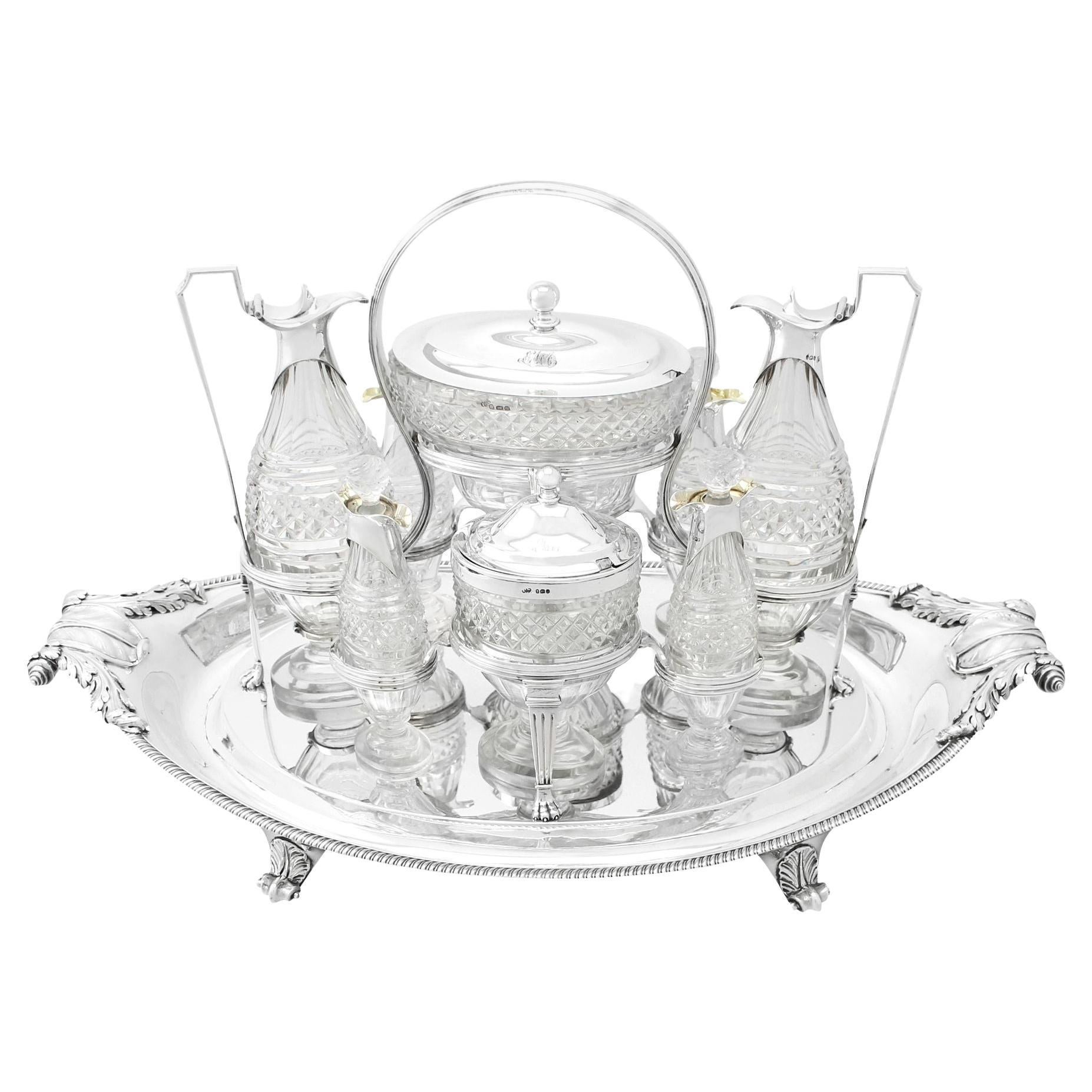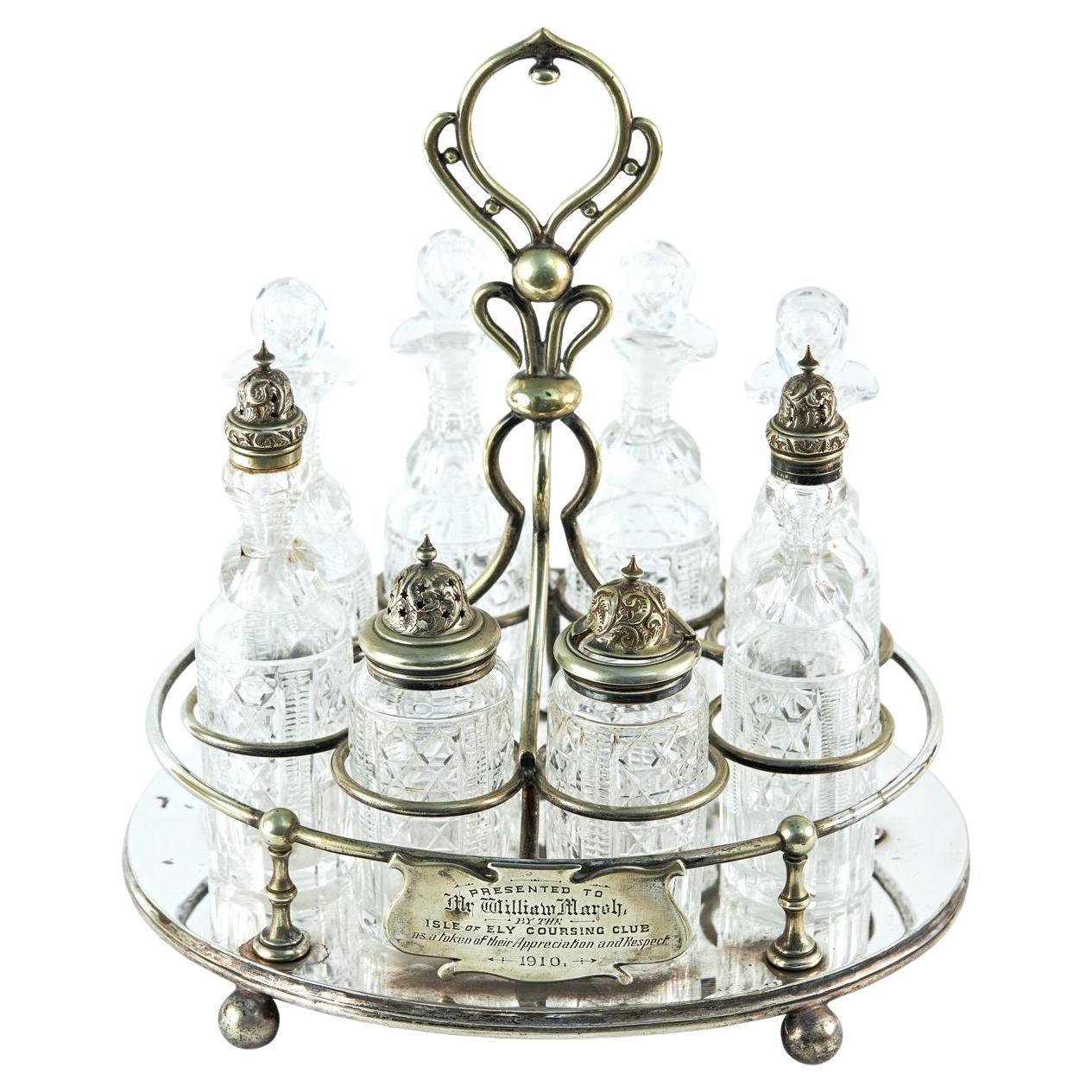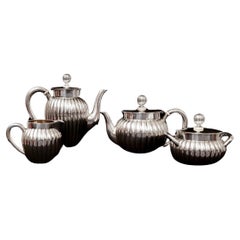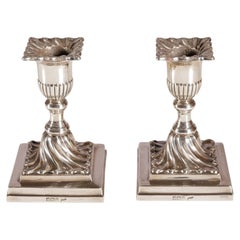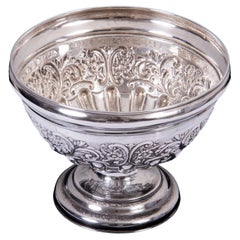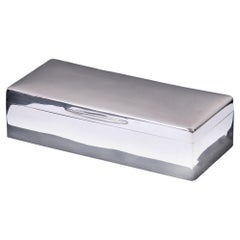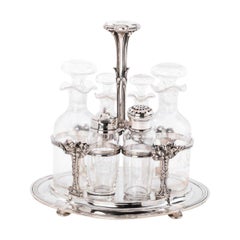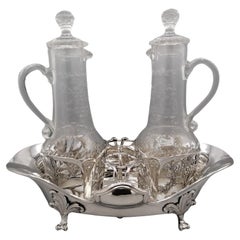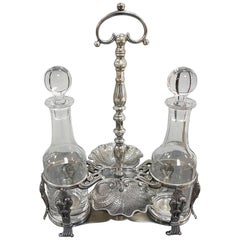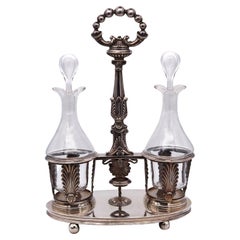Items Similar to Odiot Paris 900/- silver cruet with original Glass inserts, 1894
Want more images or videos?
Request additional images or videos from the seller
1 of 12
Odiot Paris 900/- silver cruet with original Glass inserts, 1894
$3,853.83
£2,865.05
€3,250
CA$5,340.72
A$5,953.87
CHF 3,105.19
MX$71,996.12
NOK 39,033.75
SEK 36,933.73
DKK 24,743.09
About the Item
Odiot Paris 900/- silver cruet
oval stand with cross-band decoration, with 4 feet and central handle, around which are grouped holders for the glass inserts.
These consist of 2 jugs with spouts and stoppers, 2 small bottles with stoppers, a shaker and 1 mustard jar with lid and spoon.
stamped “Odiot Paris 1894”, all glass inserts in original condition with cut flower decoration
Height 24 cm, width 24.5 cm, depth 20 cm
Odiot is an iconic French company famous for its silver and gold products. The Odiot family has produced many talented craftsmen over the years.
It began in 1690, when Jean-Baptiste-Gaspard Odiot was appointed purveyor of the royal court and became the personal silversmith of King Louis XV. However, one who brought real fame and worldwide recognition to the house was Jean-Baptiste-Claude.
The son of Jean-Claude Odiot and the grandson of mentioned Jean-Baptiste-Gaspard was born on June 8, 1763 in Paris. At the age of 16, he joined the dragoon regiment and rose to the rank of colonel-general.
In December 1785, Jean-Baptiste-Claude Odiot received a certification as a silversmith and his own hallmark (the initials JBCO around the helmet, which after the Revolution were replaced by bellows). 42 years (from 1785 to 1827) he created many exquisite products for the most fastidious taste, giving preference to the Empire style and antique motifs. It is known that Odiot made a couple of goblets and coffee urn for Thomas Jefferson according to the sketches of the US 3rd President.
Jean-Baptiste-Claude Odiot was not only a talented silversmith, but also a brave warrior: in 1814, together with General Bon-Adrien Jeannot de Moncey, he participated in the defense of Paris at the Clichy outpost during the wars of Napoleonic France and the coalition of European countries. He was awarded Order of the Legion of Honor (Colonel-General Odiot even ordered from the famous artist Horace Vernet a painting that immortalized this event ("La Barrière de Clichy. Défense de Paris, le 30 mars 1814"), which can be seen today in the Louvre).
The relationship between Jean-Baptiste-Claude Odiot and the Emperor Napoleon Bonaparte and his family is very interesting. Despite the fact that Odiot was not officially appointed as purveyor to the emperor (which played into the hands of the silver house during the Restoration) after the bankruptcy in 1809 of the previous one, Henri Auguste, Odiot made many products for him, his family and those close to him.
The first order came in October 1801: together with the jeweler Marie-Étienne Nitot, Odiot made the consular sword of Napoleon. In 1802, the sword was awarded a gold medal at the World Fair 1802.
In 1806, Jean-Baptiste-Claude Odiot took triumphal part again at the World Fair, this time with a silver gilded tripod in the antique style. In the same year, the emperor's mother, Letizia Bonaparte, ordered from the master a large tableware made of gilded silver, which was fully completed in 1808.
In 1810, commissioned by the prefect of the Seine department in Paris, Nicolas Froсhaut, Jean-Baptiste-Claude Odiot, together with the French sculptor and caster Pierre-Philippe Thomire, had a boudoir made of gilded silver and lapis lazuli according to the drawings of the artist Pierre-Paul Prudhon. This is a gift for Marie-Louise of Austria on the occasion of her marriage to Napoleon Bonaparte.
A year later, the imperial couple received a gift from the city of Paris “The Cradle of the King of Rome” (Berceau du roi de Rome) on the occasion of the birth of the heir, Napoleon II. The cradle was also created by Odio and Thomir from Prudon's designs.
After the fall of Bonaparte and during the Restoration, the House of Odiot not only did not lose its rich clientele, but also began to receive orders from kings and aristocrats from all over Europe: First Duke of Wellington Arthur Wesley, Austrian diplomat and Prince Clemens Metternich, King of Prussia Friedrich Wilhelm III, King of Württemberg William I and Prince Regent of England George IV.
Jean-Baptiste-Claude Odiot takes part again in two World Exhibitions - in 1819 and 1823.
Also, from 1819 to 1835, the master donates part of his works to the government of France: for example, thirty bronze objects and a silver vase end up in the Luxembourg Palace (more precisely, its wing, set aside for a museum). At the end of the century, the collection was transferred to the Museum of Decorative Arts. In 1907-1908. another famous jeweler, Christofle, has silver-plated Odiot state-donated bronzes.
In 1827, Jean-Baptiste-Claude retired (he died in 1850), handing over the business to his son, Charles-Nicolas Odiot. He becomes the purveyor of the court of King Louis Philippe and his family.
The Odiot empire was succeeded in 1856 by Charles-Nicolas's son, Jean-Baptiste-Gustave. He became a supplier to the royal court of the Russian Empire under Alexander II, and also received the largest order in the history of the house: a table service for 3000 pieces of solid gold for Said Pasha, Viceroy of Egypt. It was Jean-Baptiste-Gustave who was the first to register the famous Odiot brand in 1864: the letter O and an old lamp.
Jean-Baptiste-Gustave Odio was the last of the glorious dynasty. Since he left no heirs, in 1894 he registered a new company - Odiot Prévost Récipon et Cie - which he runs together with Emile Prevost and Paul-Edouard Resipon. From 1906 to 1956 Odiot merges with another famous silver house, Boulenger. Since 1956, Odiot is again an independent company with the highest quality products, which still exists today.
- Creator:Maison Odiot Paris (Maker)
- Dimensions:Height: 9.45 in (24 cm)Width: 9.65 in (24.5 cm)Depth: 7.88 in (20 cm)
- Style:Belle Époque (Of the Period)
- Materials and Techniques:
- Place of Origin:
- Period:
- Date of Manufacture:1894
- Condition:Wear consistent with age and use.
- Seller Location:Münster, DE
- Reference Number:1stDibs: LU9172245823322
About the Seller
5.0
Recognized Seller
These prestigious sellers are industry leaders and represent the highest echelon for item quality and design.
Established in 2000
1stDibs seller since 2023
- ShippingRetrieving quote...Shipping from: Münster, Germany
- Return Policy
Authenticity Guarantee
In the unlikely event there’s an issue with an item’s authenticity, contact us within 1 year for a full refund. DetailsMoney-Back Guarantee
If your item is not as described, is damaged in transit, or does not arrive, contact us within 7 days for a full refund. Details24-Hour Cancellation
You have a 24-hour grace period in which to reconsider your purchase, with no questions asked.Vetted Professional Sellers
Our world-class sellers must adhere to strict standards for service and quality, maintaining the integrity of our listings.Price-Match Guarantee
If you find that a seller listed the same item for a lower price elsewhere, we’ll match it.Trusted Global Delivery
Our best-in-class carrier network provides specialized shipping options worldwide, including custom delivery.More From This Seller
View AllSilver Teaset Brothers Grachev St. Petersburg Russian 1899-1908
By Grachev Brothers
Located in Münster, DE
Tea core, set of tea and mocha pot, milk and sugar, Grachev brothers St. Petersburg, court jewelers of the tsar, date of origin 1899 - 1908, silver, total weight 1.215 grams, hallmar...
Category
Antique Late 19th Century Russian Art Nouveau Tea Sets
Materials
Silver
Pair of Silver Candlesticks Walker & Hall Sheffield 1902
By Walker & Hall
Located in Münster, DE
Pair of candlesticks, silver 925/-, maker Walker & Hall, Sheffield 1902, square stand, removable spouts, organic shaped shaft and spout
Height 12 cm, diameter base 8 x 8 cm
Walker...
Category
Early 20th Century British Belle Époque Sterling Silver
Materials
Silver
$1,754 Sale Price / set
20% Off
925/- Sterling Silver Rose Bowl Birmingham 1905
Located in Münster, DE
Rose Bowl, 925/- sterling silver, England, Birmingham, 1905, stamped, wall with floral decoration
Height 11 cm, diameter 13.5 cm
Rose bowls were used to create lavish table decorat...
Category
Antique Early 1900s English Belle Époque Tableware
Materials
Silver
Lidded box, London 1920, 925/- sterling silver
Located in Münster, DE
Lidded box, London 1920, 925/- sterling silver, on wooden base with adjustable dividers, stamped
Height 6.5 cm, width 20.5 cm, depth 9 cm
Category
Vintage 1920s British Art Deco Sterling Silver
Materials
Sterling Silver
Pair of French Empire Candlesticks Bronze 1810
Located in Münster, DE
Pair of candlesticks, Empire, around 1810, patinated and fire-gilt bronze
Height 27 cm, diameter base 13 cm
Empire candelabra: works of art
French Empire candelabra and Empire cha...
Category
Antique Early 19th Century French Empire Sterling Silver
Materials
Bronze
$2,347 / set
Pair of French Empire Candlesticks Bronze 1800
Located in Münster, DE
Pair of candlesticks, Empire, around 1810, patinated and fire-gilt bronze
Height 29 cm, diameter base 12.5 cm
Empire candelabra: works of art
French Empire candelabra and Empire c...
Category
Antique Early 19th Century French Empire Sterling Silver
Materials
Bronze
$2,347 / set
You May Also Like
Silversmith Odiot - Cruet / Vinegar In Solid Silver/Crystal Late 19th Century
By Maison Odiot Paris
Located in SAINT-OUEN-SUR-SEINE, FR
Oval-shaped solid silver cruet/vinegar, terrace mounted on four spinning tops, comprising four crystal bottles,
a sprinkler and a mustard bottle surrounded by a frame decorated with...
Category
Antique Late 19th Century French Napoleon III Tableware
Materials
Sterling Silver
Antique French silver cruet made in France - Strasbourg 1750 - 1796
By Arval Argenti Valenza
Located in VALENZA, IT
Solid silver oil cruet, produced in France in Strasbourg between 1750 and 1796 as evidenced by the state marks.
The shape is a boat, where 4 feet made with the casting technique have...
Category
Antique 18th Century French Baroque Tableware
Materials
Crystal, Silver
20th Century Italian Silver - Cristal Venetian Replica Cruet
By Argenterie di Milano
Located in VALENZA, IT
Silver 800°°/°°° Cruet - Venetian Art replica.
The original 18th century is from a private collection
The two bottle racks are made up of chiselled scrolls that also act as feet
Two ...
Category
Vintage 1960s Italian Baroque Serving Pieces
Materials
Silver
France Lyon 1838 By Armand Caillat Neoclassical Hoilier Cruet Set .950 Sterling
By Thomas-Joseph Armand-Cailliat
Located in Miami, FL
Beautiful Cruet set designed by Armand Caillat (1822-1901).
Very nice French neo-classical piece from the period of the king Louis Phillipe (1830-184...
Category
Antique 1830s French Neoclassical Sterling Silver
Materials
Silver, Sterling Silver
$2,089 Sale Price / set
30% Off
Paul Storr Sterling Silver and Cut Glass Cruet Service
By Paul Storr
Located in Jesmond, Newcastle Upon Tyne
A magnificent, fine and impressive, antique Georgian English sterling silver and cut-glass nine bottle table cruet set made by Paul Storr; an addition to our collectable dining silverware.
This magnificent and large antique George III cruet...
Category
Antique Early 1800s English Georgian Centerpieces
Materials
Silver, Sterling Silver
Large Antique Quality Oval 8 Piece Silver Plated Cruet Set
Located in Ipswich, GB
Large Antique Quality Oval 8 Piece Silver Plated Cruet Set, having a large oval shaped silver plated cruet set with 8 original cut glass bottles, 4 with the original cut glass stoppe...
Category
Early 20th Century Edwardian Glass
Materials
Glass
More Ways To Browse
Adrien Claude
Bon Bon Spoon
Antique Silver Plated Coffee Urn
Hector Aguilar Aztec
Helmut Adler
Hermes Tart Platter
International Sterling 1810
International Sterling Du Barry
Lalique Barsac
Lalique Bourgueil
Lauffer Design 3
Lauffer Norway
Lenox China Service For 12
Full Set Of Nickel Bronze Flatware
Georg Jensen Prism Stainless
Gold Imari Peacock Plate
Hackman Lion
Holmes And Edwards Flatware
